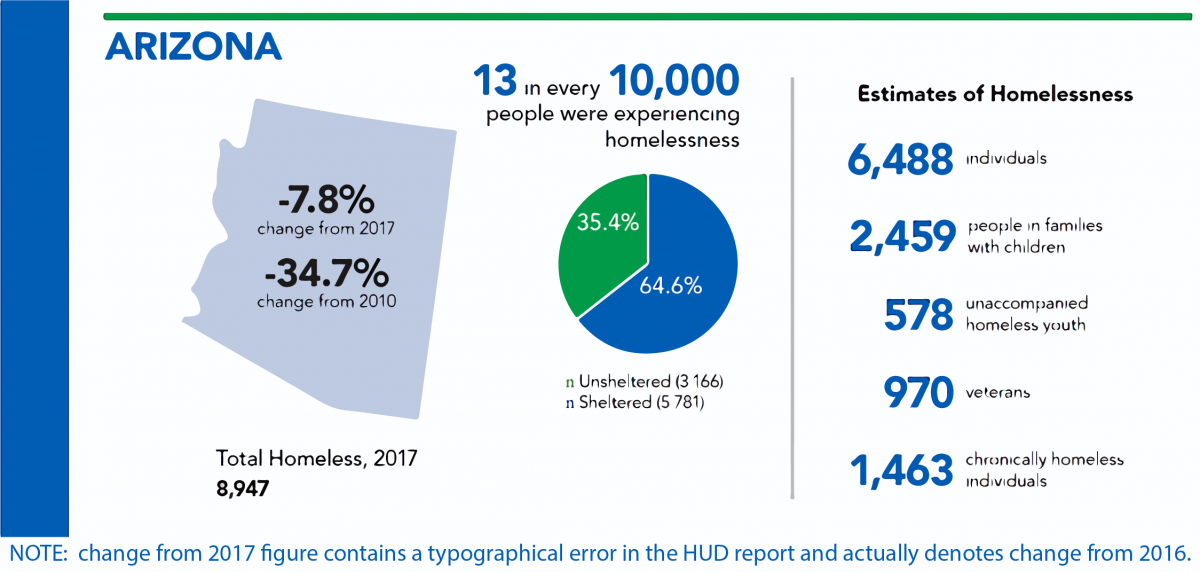Arizona Homelessness
ARIZONA HOMELESSNESS FELL NEARLY 35% SINCE 2010
In its annual report to Congress on homelessness, issued last month, the U.S. Department of Housing and Urban Development (HUD) noted that the percentage of people experiencing homelessness in Arizona has fallen nearly 35 percent over the past seven years. Arizona was recognized as one of 10 states that have experienced the largest decreases in homelessness over the period. While Arizona’s homeless figures decreased overall, the number of individuals categorized as chronically homeless increased by 136 statewide in the past year. Additionally, despite being one of largest cities in the country, Arizona’s largest city, Phoenix, was not among the cities with the largest numbers of people experiencing homelessness.
The report analyzes data gathered from an annual Point-in-Time (PIT) Count, which are unduplicated 1-night estimates of both sheltered and unsheltered homeless populations carried out by local Continuum of Cares nationwide during the last week of January each year. Continuum of Cares (CoC) are local planning bodies responsible for coordinating the full range of homelessness services in a geographic area. Three CoCs operate in Arizona – the Maricopa Regional Continuum of Care, the Tucson/Pima County Continuum of Care, and the Balance of State Continuum of Care. Applications for HUD CoC aid made available by the federal government for homeless reduction efforts may only be submitted by a CoC.
Arizona’s Balance of State Continuum of Care (AZBOSCOC), which consists of multiple, regionally based efforts, is administered by the Arizona Department of Housing (ADOH), and encompasses the 13 rural counties in the state. Part of ADOH’s efforts in overseeing the administrative and unique local service coordination aspects of the CoC for rural Arizona is to encourage each region to grow its own resources, and in areas where there are none, to reach out to facilitate cross-regional collaboration. Currently, nine out of the 13 counties, covering over 80 percent of the area and population of the AZBOSCOC, include a regionally organized effort to end homelessness.
|
Footnotes 1 Phoenix and Mesa, both recognized as major cities, are located within the same CoC, the Maricopa Regional Continuum of Care, which effects their placement in the ranking of Major City CoC statistics. 2 All Balance of State regions are not created equal. Arizona’s Balance of State encompasses 95,585 square miles, a territory larger than 38 other entire states; and, an estimated 2016 population of 1.6 million, a population larger than 12 other states’ entire populations. Arizona is the sixth largest state in the nation with respect to square miles and has the 16th largest population in the country. |
Despite Arizona’s overall decline in homelessness, the report singled out some Arizona figures in the report. Such analysis, however, should also include a comparison of outstanding attributes of the areas (e.g., size and population, as described in the Footnotes) before drawing conclusions. HUD’s report does not provide such context.
-
Phoenix/Mesa/Maricopa County1 reported:
-
the 10th largest number of homeless individuals concentrated in major cities at 3,805;
-
the eighth largest number of homeless people in families with children in major cities at 1,800;
-
the 10th largest number of unaccompanied homeless youth in major cities at 320;
-
the area was not amongst the 10 highest major cities for reported numbers of unsheltered veterans or chronically homeless.
-
Arizona’s Balance of State2 had the seventh highest reported number of chronically homeless individuals at 358 when compared to other Balance of State efforts. And, nearly 84 percent of the chronically homeless in Arizona’s rural counties are unsheltered.
The vastness of Arizona’s Balance of State territory creates challenges in organizing concerted efforts to serve Arizona’s rural homeless populations. Services are always more available and easier to arrange in the more highly populated rural areas, such as Flagstaff, and become more difficult in large, but less populated counties of the state where services are limited or non-existent.
While ADOH does not administer the Maricopa Regional and the Tucson/Pima County Continuum of Cares, it does work closely with those CoCs and participates in providing funding and planning for homeless activities in all areas of the state.
View the 2017 Annual Homeless Assessment Report (AHAR) to Congress.

